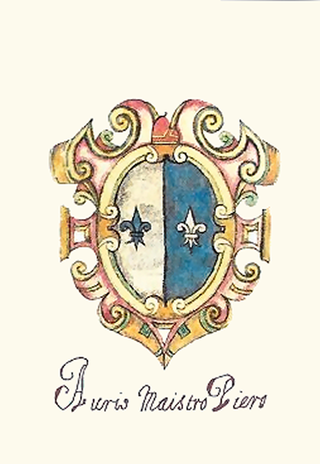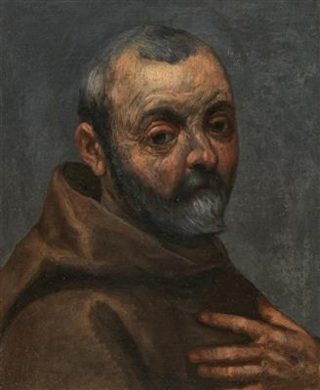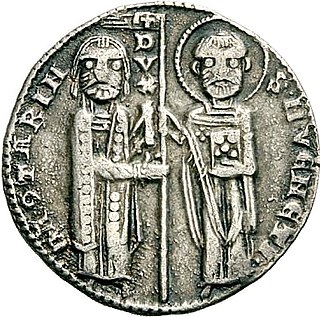Girolamo Gamberati or Gamberato (1550-1628) was an Italian painter active in his native Venice.

Girolamo Gamberati or Gamberato (1550-1628) was an Italian painter active in his native Venice.

He learned design from Giuseppe Porta and color from Jacopo Palma il Giovane, painters with whom he collaborated on projects in the Doge's Palace. [1] In the Sala del Maggior Consiglio, he painted an episode of the History of Ancona, placed above the door leading to the Quarantìa della Sala. It depicts a meeting in Ancona between Doge Sebastiano Ziani, Emperor Frederick Barbarossa, and Pope Alexander III, where all three were given gold umbrellas by the citizens. The pope gives his to the Doge.

Ancona is a city and a seaport in the Marche region of Central Italy, with a population of around 101,997 as of 2015. Ancona is the capital of the province of Ancona and of the region. The city is located 280 km (170 mi) northeast of Rome, on the Adriatic Sea, between the slopes of the two extremities of the promontory of Monte Conero, Monte Astagno and Monte Guasco. The hilly nature around Ancona is a strong contrast to the flatter coastline in areas further north.

Orio Mastropiero, forename sometimes rendered as Aurio and surname as Malipiero, was a Venetian statesman who served as the Doge of Venice from 1178 to 1192. He was elected by the Council of Forty in 1178 following the retirement of Sebastiano Ziani. Prior to this he had been an ambassador to Sicily in 1175, tasked with drawing up a treaty with King William II. He had also been the electors' first choice for doge following the death of Vitale II Michiel in 1172, but stepped aside in favour of Ziani, an older and wealthier man.

Pietro da Cortona was an Italian Baroque painter and architect. Along with his contemporaries and rivals Gian Lorenzo Bernini and Francesco Borromini, he was one of the key figures in the emergence of Roman Baroque architecture. He was also an important designer of interior decorations.

Pellegrino Tibaldi, also known as Pellegrino di Tibaldo de Pellegrini, was an Italian mannerist architect, sculptor, and mural painter.

Antonio Vassilacchi, also called L'Aliense, was a Greek painter, who was active mostly in Venice and the Veneto.
Giovanni Balducci, called Il Cosci after his maternal uncle, was an Italian mannerist painter.

Iacopo Negretti, best known as Jacopo or Giacomo Palma il Giovane or simply Palma Giovane, was an Italian painter from Venice and a notable exponent of the Venetian school.

LudovicoBrea was an Italian painter of the Renaissance, active mainly in and near Genoa.

Gregorio Lazzarini was an Italian painter of mythological, religious and historical subjects, as well as portraits. One of the most successful Venetian artists of the day, a prominent teacher, and father to a significant school of painting, he is best known for having first trained Giambattista Tiepolo, who joined his workshop in 1710 at the age of fourteen. His own style was somewhat eclectic.

Andrea Celesti (1637–1712) was an Italian painter of the Baroque period, working in Venice. His style gravitated over the years from a turgid and academic weightiness to a lighter, looser brushstroke.

Jacopo Contarini (Giacomo) was the 47th Doge of Venice, from 6 September 1275 to his abdication on 6 March 1280.

Giovanni Biliverti was an Italian painter of the late-Mannerism and early-Baroque period, active mainly in his adoptive city of Florence, as well as Rome.

Pietro Bellotti (1625–1700) was an Italian painter active in the Baroque period.

Marco Vecellio (1545–1611) was an Italian painter of the Renaissance period. He was also called Marco di Tiziano, since he was Titian's nephew. He was born and active mainly in Venice. He accompanied his distinguished uncle in the journeys to Rome and Germany. He was the favorite pupil of Titian, and approached nearer to his style than any other member of the family. There are several pictures by him in the Doge's palace, among the best an allegory in the ante-chamber to the Sala del Gran Consiglio. Another good example is a picture in the Sala della Bussola, Doge Leonardo Donato before the Virgin and Infant Christ. He also painted for churches at Venice, Treviso, and in the Friuli, among other things a Christ fulminating the world, and The Virgin on Earth Sending the Two Founders Dominic and Francis for the church of San Zaniopolo at Venice.

Giovanni Dandolo was the 48th Doge of Venice, elected late in his life on 31 March 1280. He died on 2 November 1289. During his reign, the first Venetian gold ducat was introduced into circulation.

Pietro Polani was the 36th Doge of Venice. He reigned from 1130 to 1148.

Vitale II Michiel was Doge of Venice from 1155 to 1172.

Francesco Erizzo was the 98th Doge of Venice, reigning from his election on 10 April 1631 until his death fifteen years later. His reign is particularly notable because the last year of his reign saw the beginning of a war with the Ottoman Empire for control of Crete that would last for 24 years and dominate the geopolitics of the Mediterranean.

Francesco Loredan was a Venetian statesman and magnate who served as the 116th Doge of Venice from 18 March 1752 until his death in 1762. He was a member of the noble House of Loredan, head of its Santo Stefano branch, and the only Doge, as well as the last male, to be awarded the Golden Rose by the Papacy.

Gian Girolamo Albani (1509–1591) was an Italian Roman Catholic cardinal of Albanian descent.